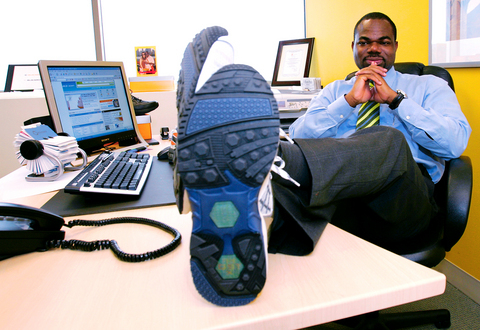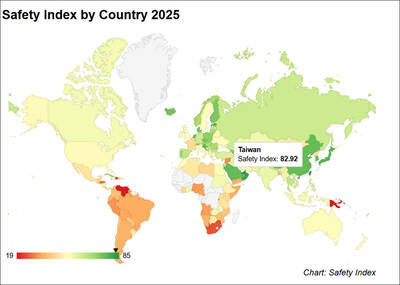Isaac Daniel calls the Global Positioning System chip he has embedded into a line of sneakers "peace of mind."
He wishes his eight-year-old son had been wearing them when he got a call from his school in 2002 saying the boy was missing. The worried father hopped a flight to Atlanta from New York, where he had been on business, to find the incident had been a miscommunication and his son was safe.
Days later, the engineer started working on a prototype of Quantum Satellite Technology, a line of US$325 to US$350 adult sneakers that will hit shelves next month. It promises to locate the wearer anywhere in the world with the press of a button. A children's line will be out this summer.

PHOTO: AP
"We call it a second eye watching over you," Daniel said.
It's the latest implementation of satellite-based navigation into everyday life -- technology that can be found in everything from cell phones that help keep kids away from sexual predators to fitness watches that track heart rate and distance. Shoes aren't as easy to lose, unlike phones, watches and bracelets.
The sneakers work when the wearer presses a button on the shoe to activate the GPS. A wireless alert detailing the location is sent to a 24-hour monitoring service that costs an additional US$19.95 a month.
In some emergencies -- such as a lost child or Alzheimer's patient -- a parent, spouse or guardian can call the monitoring service, and operators can activate the GPS remotely and alert authorities if the caller can provide the correct password.
But the shoe is not meant for non-emergencies -- like to find out if a teen is really at the library or a spouse is really on a business trip. If authorities are called and it is not an emergency, the wearer will incur all law enforcement costs, Daniel said.
Once the button is pressed, the shoe will transmit information until the battery runs out.
While other GPS gadgets often yield spotty results, Daniel says his company has spent millions of dollars and nearly two years of research to guarantee the accuracy of the product's chip, which is tucked into the bottom of the shoe.
Experts say GPS accuracy often depends on how many satellites the system can tap into. Daniel's shoe and most GPS devices on the market rely on four.
"The technology is improving regularly. It's to the point where you can get fairly good reflection even in areas with a lot of tree coverage and skyscrapers," said Jessica Myers, a spokeswoman for Garmin International Inc, a leader in GPS technology based in Kansas.
"You still need a pretty clear view of the sky to work effectively," she said.
Daniel, who wears the shoes when he runs every morning, says he tested the shoes on a recent trip to New Jersey.
It tracked him down the Atlantic Coast to the Miami airport and through the city to a specific building.
The company has also put the technology into military boots and is in talks with Colombia and Ecuador, he said.
But retail experts say the shoe might be a tough sale to brand-conscious kids.
"If [parents] can get their kids to wear them, then certainly there is a marketplace. But I think the biggest challenge is overcoming ... the cool marketplace," said Lee Diercks, managing director of New Jersey-based Clear Thinking Group, an advisory firm for retailers.
The GPS sneakers, available in six designs, resemble most other running shoes. The two silver buttons -- one to activate and one to cancel -- are inconspicuous near the shoelaces.
The company is selling 1,000 limited-edition shoes online and already has orders for 750, Daniel said.
Parents who buy the pricey sneakers don't have to worry about their kids outgrowing them fast.
This fall, the company is unveiling a plug-and-wear version that allows wearers to remove the electronics module from their old shoes and plug it into another pair of Daniel's sneakers.

AIR SUPPORT: The Ministry of National Defense thanked the US for the delivery, adding that it was an indicator of the White House’s commitment to the Taiwan Relations Act Deputy Minister of National Defense Po Horng-huei (柏鴻輝) and Representative to the US Alexander Yui on Friday attended a delivery ceremony for the first of Taiwan’s long-awaited 66 F-16C/D Block 70 jets at a Lockheed Martin Corp factory in Greenville, South Carolina. “We are so proud to be the global home of the F-16 and to support Taiwan’s air defense capabilities,” US Representative William Timmons wrote on X, alongside a photograph of Taiwanese and US officials at the event. The F-16C/D Block 70 jets Taiwan ordered have the same capabilities as aircraft that had been upgraded to F-16Vs. The batch of Lockheed Martin

GRIDLOCK: The National Fire Agency’s Special Search and Rescue team is on standby to travel to the countries to help out with the rescue effort A powerful earthquake rocked Myanmar and neighboring Thailand yesterday, killing at least three people in Bangkok and burying dozens when a high-rise building under construction collapsed. Footage shared on social media from Myanmar’s second-largest city showed widespread destruction, raising fears that many were trapped under the rubble or killed. The magnitude 7.7 earthquake, with an epicenter near Mandalay in Myanmar, struck at midday and was followed by a strong magnitude 6.4 aftershock. The extent of death, injury and destruction — especially in Myanmar, which is embroiled in a civil war and where information is tightly controlled at the best of times —

Taiwan was ranked the fourth-safest country in the world with a score of 82.9, trailing only Andorra, the United Arab Emirates and Qatar in Numbeo’s Safety Index by Country report. Taiwan’s score improved by 0.1 points compared with last year’s mid-year report, which had Taiwan fourth with a score of 82.8. However, both scores were lower than in last year’s first review, when Taiwan scored 83.3, and are a long way from when Taiwan was named the second-safest country in the world in 2021, scoring 84.8. Taiwan ranked higher than Singapore in ninth with a score of 77.4 and Japan in 10th with

SECURITY RISK: If there is a conflict between China and Taiwan, ‘there would likely be significant consequences to global economic and security interests,’ it said China remains the top military and cyber threat to the US and continues to make progress on capabilities to seize Taiwan, a report by US intelligence agencies said on Tuesday. The report provides an overview of the “collective insights” of top US intelligence agencies about the security threats to the US posed by foreign nations and criminal organizations. In its Annual Threat Assessment, the agencies divided threats facing the US into two broad categories, “nonstate transnational criminals and terrorists” and “major state actors,” with China, Russia, Iran and North Korea named. Of those countries, “China presents the most comprehensive and robust military threat